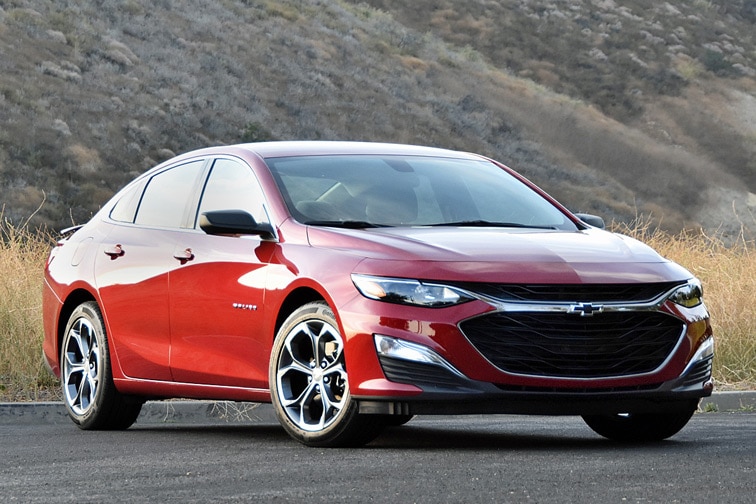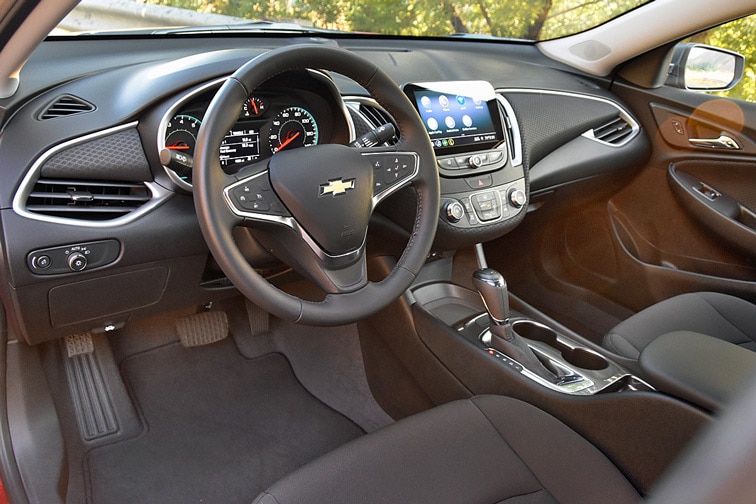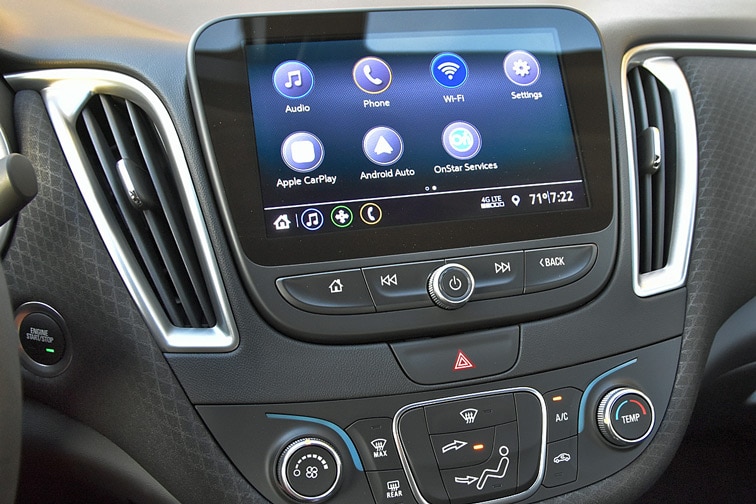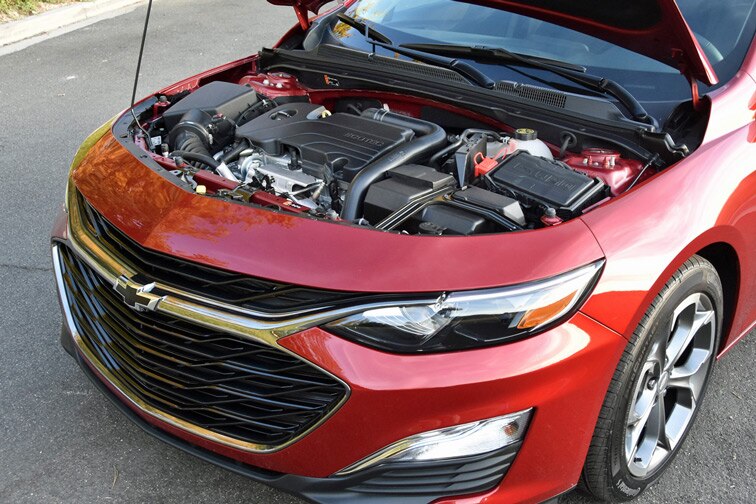2020 Chevrolet Malibu Review: Fading to Black?
Chevrolet may be cutting back on sedans, but the mid-size Malibu is the best it’s been since the 1960s

Christian Wardlaw
For 2020, gas-powered sedans wearing bowtie badges are fading away, as Chevrolet shifts its focus to SUVs, trucks, EVs, and its long-awaited mid-engine Corvette. Amid all that shifting, the mid-size 2020 Chevy Malibu may just prove to be the last Chevy sedan standing.
The Malibu is built in Missouri, and waves one of the last flags for mid-size sedans for Detroit’s “big three.” During a freshening for 2019, Chevy added a sporty looking RS trim level providing a sportier look without tipping the price scales.
That’s the version Chevrolet loaned us to review, and we scooted off to Malibu, California, for some seat time. Painted Cajun Red and equipped with a Convenience Package, the test car was priced at MSRP $25,865, including the $875 destination charge.
Does this aging mid-size sedan—whose last major redesign was in 2016—make a case for consideration, or have the dominant competitors in the class permanently outrun it, leaving it to fade like a weathered To The Beach sign? That’s the question we set out to answer.
 Christian Wardlaw
Christian Wardlaw
THE BEST MALIBU SINCE THE 1960s
Deceptively satisfying to live with and drive, the Malibu RS is an affordable, stylish, comfortable, and practical back-to-basics form of mid-sized transportation. Uncomplicated, in spite of its inherent technical sophistication, the Malibu is refreshingly simple. You get in. You drive. Nothing about the car causes any head scratching.
Taken as a whole, this is the best Malibu since the model’s 1960s heyday. It also competes against worthy rivals with newer designs and more standard safety features. This reality serves to magnify a handful of Malibu’s flaws.
Chevrolet cancelled the Malibu Hybrid for 2020, making the offerings somewhat less competitive. Consumers were apparently uninterested in the car, even though it was rated at an EPA-estimated 46 combined mpg.
 Christian Wardlaw
Christian Wardlaw
MALIBU RS GETS BACK TO BASICS
Like other mid-size sedans from mainstream brands, the Malibu’s interior features a combination of quality materials and hard plastic surfaces. To Chevrolet’s credit, gloss and shine are minimized, which helps the cabin appear more expensive than it is. In the Malibu RS, fabric matching the seats is used as trim for the dashboard, an odd-but-compelling detail.
Controls are simple to find and operate. In particular, separate knobs and buttons for the stereo and climate controls make changing radio stations, adjusting volume, and modifying the heat and air conditioning remarkably easy for a modern car.
Comfort levels are high. Both front seats offer height adjustment, and the RS trim’s fabric upholstery is appealing from both a visual and tactile standpoint. The rear seat offers plenty of room and lots of leg support, but climate control vents are restricted to higher-trim versions.
Drivers enjoy excellent forward visibility, and the wide side mirrors are especially helpful for changing lanes. Trunk space measures 15.7 cubic feet, which is on par with most competitors.
 Christian Wardlaw
Christian Wardlaw
THE SAFE CHOICE COMES AT A PRICE
Equipped with Chevrolet’s latest infotainment system, the Malibu’s standard 8-inch touchscreen features intuitive operation, modern graphics, and quick response to input. Regardless of trim level, the system includes Apple CarPlay, Android Auto, and access to OnStar subscription services, including a 4G LTE WiFi hotspot.
A navigation system is optional, but given the standard smartphone projection technology, it’s obsolete out of the box. The premium Bose audio upgrade likely offers more utility for the money, but it’s only offered on the range-topping Premier trim level.
You also need to upgrade to Malibu’s LT or Premier trim in order to access the available advanced driving assistance systems (ADAS). In a segment where the least expensive models from the competition are equipped with features like forward-collision warning and automatic emergency braking, this feels like a missed opportunity.
What every Malibu does have, though, is a feature called Teen Driver technology. It creates a driving report card for the parents of teenagers, showing how their offspring used the car on a night out on the town, for instance.
A rear seat reminder system is also standard, helping to remind parents that they might be forgetting about someone important—and who is quietly sleeping—in the back seat. With an active OnStar subscription, automatic collision notification and SOS emergency calling also stand ready to assist when necessary.
According to the
 Christian Wardlaw
Christian Wardlaw
SMALL BUT THIRSTY STANDARD ENGINE
Equipped with a standard turbocharged 1.5-liter 4-cylinder engine, this 3,135-pound car supplies 160 horsepower and 184 lb.-ft. of torque. A continuously variable automatic transmission (CVT) powers the front wheels and, thanks in part to a standard automatic engine stop/start system, the
The test car did not live up to that figure, instead achieving an average of 27.2 mpg. This isn’t surprising, though, because the engine exhibits what’s known as turbo lag as you begin to accelerate. It’s a momentary delay in power delivery as the turbocharger spools up and delivers power to the wheels. For many drivers, the brain compensates for this delay by pushing harder on the accelerator pedal. That forces the engine to work harder, which in turn requires more fuel.
There is an alternative to the standard 1.5-liter engine, but it’s only available on the Premier trim level. That version of the Malibu has a turbocharged 2.0-liter 4-cylinder good for 250 hp and 260 lb.-ft. of torque, and it is married to a satisfying 9-speed automatic.
It utterly transforms the Malibu’s driving dynamics.
 Christian Wardlaw
Christian Wardlaw
ENJOYABLE RIDE AND HANDLING
Aside from the lag on the standard powertrain, the Malibu is rewarding to drive. Quick, accurate, and nicely weighted steering feels good in your hands, and the brakes are both responsive and easily modulated as you bring the car to a halt.
The ride is on the taut side, which means you’ll feel the road’s undulations. At the same time, though, the suspension filters most of the vibration and harshness.
Equipped with RS-specific 18-inch wheels and low-profile tires, the Malibu felt remarkably athletic along the winding roads for which it is named. The capable handling and robust vehicle engineering make the merely adequate 1.5-liter engine and CVT a bit of a bummer.
WILL YOU CROSS OVER TO THIS CHEVROLET?
Chevrolet’s parent company (General Motors) has publicly announced that it is
But will those who still love cars buy a Malibu? If Chevrolet finds a way to offer more safety technology on less expensive trim levels—like nearly every rival—the Malibu would deserve the same consideration as other mid-size family sedans.
Vehicle Stats
2020 Chevrolet Malibu
Trim: RS
Base Price:* $25,095
Price As Tested:* $25,865
Selected Specifications:
Fuel Economy: 29/36/32 (city/hwy/comb)
Power: 160 hp
Torque: 184 lb-ft
Seating Capacity: 5
Advanced Safety Systems:
Teen Driver
Rear Seat Reminder
Available on LT and Premier Trims:
Forward- collision warning
Automatic emergency braking
Blind-spot monitoring
Rear cross-traffic alert
Lane- departure warning
Lane- keeping assist
Other Key Trims:*
L: $22,970
LS: $24,095
LT: $27,495
Premier: $34,195
*(MSRP + Destination)
Written by humans.
Edited by humans.
 Christian Wardlaw
Christian WardlawMy first word was “car.” That’s what I’m told, anyway. For as long as I can remember, I’ve been obsessed with them. The design. The engineering. The performance. And the purpose. I’m a car enthusiast who loves to drive, but I’m also most interested in the cars, trucks, and SUVs that people actually buy. Anybody can tell you that a sports car is fast. What you need to know is whether or not you should buy that new SUV, and why. My life purpose is to help you make that decision.
Related articles
View more related articles